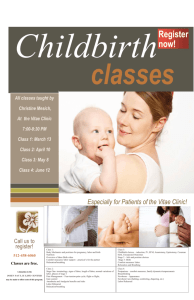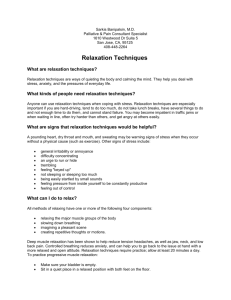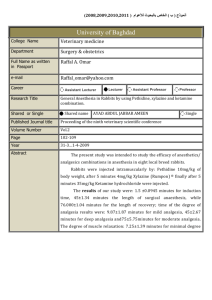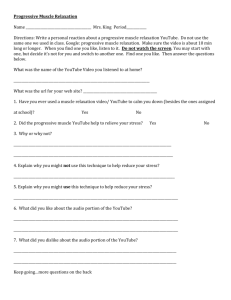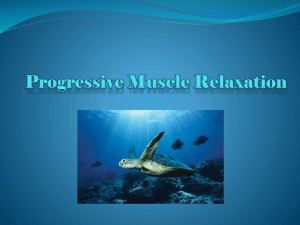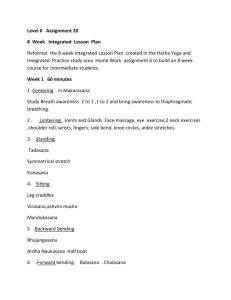Pain Management
advertisement
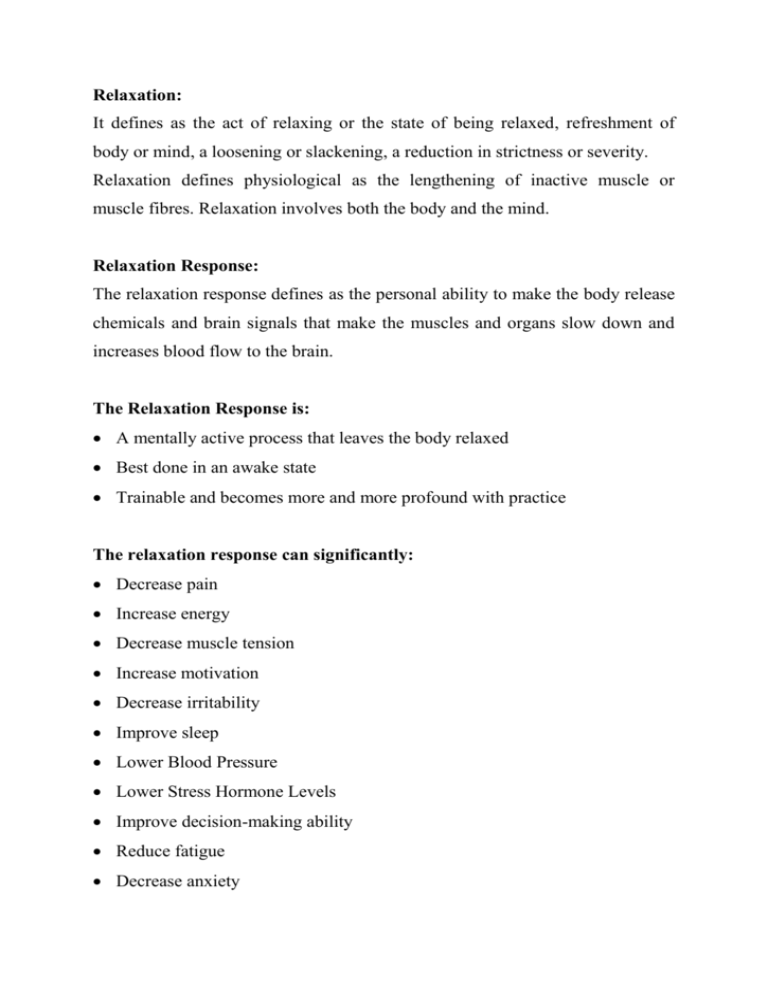
Relaxation: It defines as the act of relaxing or the state of being relaxed, refreshment of body or mind, a loosening or slackening, a reduction in strictness or severity. Relaxation defines physiological as the lengthening of inactive muscle or muscle fibres. Relaxation involves both the body and the mind. Relaxation Response: The relaxation response defines as the personal ability to make the body release chemicals and brain signals that make the muscles and organs slow down and increases blood flow to the brain. The Relaxation Response is: A mentally active process that leaves the body relaxed Best done in an awake state Trainable and becomes more and more profound with practice The relaxation response can significantly: Decrease pain Increase energy Decrease muscle tension Increase motivation Decrease irritability Improve sleep Lower Blood Pressure Lower Stress Hormone Levels Improve decision-making ability Reduce fatigue Decrease anxiety Relaxation techniques: 1. Deep breathing: The most basic of relaxation is deep breathing. One of the body's automatic reactions to stress is rapid, shallow breathing. Breathing slowly and deeply is one of the ways you can “turn off” person’s stress reaction and “turn on’’ his relaxation response. By inhaling deeply and allowing the lungs to breathe in as much oxygen as possible, person can begin to relieve the tension that can lead to negative stress. Deep breathing can be done anywhere and at any time. 2. Clearing the mind: Another relaxation technique that can help reduce stress is "clearing your mind’’. Since person’s stress response is a physical and emotional interaction, giving himself a mental "break" can help relax his body as well. When person clear his mind, he tries to concentrate on one pleasant thought, word, or image and let the rest of his worries slip away. 3. Autogenic: Yet another relaxation technique is autogenic training. By giving yourself mental "cues," you can literally tell your body how to feel, and produce the relaxation response whenever you feel tense or under stress. Autogenics is a progressive technique. You begin by concentrating on a mental suggestion such as, ‘‘My left arm feels heavy and warm.’’ As you concentrate on this 'command,' try to actually feel your arm getting heavier and warmer. Then repeat the same command, focusing on your right arm, left leg, right leg, and so on. Try to practice this exercise for about ten minutes, twice a day, or whenever you feel stressed. 4. Progressive muscular: The techniques described up until now are most helpful for people who know what relaxation feels like, but who may not know how to concentrate on relaxing. Progressive muscular relaxation is a three-step technique. First, you tense a muscle and notice how it feels; then, you release the tension and pay attention to that feeling; and finally, you concentrate on the difference between the two sensations. This exercise can be done while sitting or lying down, and only takes about fifteen minutes. 5. Stretching: One of your automatic physical responses to stress is muscle tension. A simple, easy way to loosen up tight muscles and combat stress is to do stretching exercises. The following exercises only take a few minutes and can be done at home or at work during a break. 6. Visual Imagery While some people like tensing and relaxing, others can often become more relaxed by simply imaging a beautiful place. This technique uses your mind to distract you from pain, tension, or problems. It asks you to create images in your mind that are so captivating, so rich in detail, and so all-consuming for your mind, that you get lost in the images your mind creates. 7. Massage therapy for stress relief: Getting a massage provides deep relaxation, and as the muscles in your body relaxes, your overstressed mind relaxes too. 8. Exercise: Aerobic exercise induces relaxation. Research has shown that exercise reduces stress, anxiety and muscle tension as effectively as a dose of a minor tranquilliser medication. Pain Management means the assessment of pain and, if appropriate, treatment in order to assure the needs of residents of health care facilities who experience problems with pain are met. Treatment of pain may include the use of medications or application of other modalities and medical devices, such as, heat or cold, massages, acupuncture. It also defines as the use of pharmacological and non-pharmacological interventions to control the patient’s identified pain. Psychological techniques for pain control include: 1. Cognitive strategies: such as dissociative and associative techniques. 2. Providing medical patients with sensory and procedural information to increase cognitive control and support. 3. Increasing activity level to counter chronic pain. Knowledge of pain: Pain is subjective. It is whatever the patient says it is. The nurse utilizes the nursing process in the management of pain. Adequate measurement and management of pain includes knowledge in the following areas: 1. Pain assessment: a. The nurse utilizes a developmentally appropriate, standardized pain assessment tool which includes pain measurement tools. b. Physiologic signs such as tachycardia, hypertension, diaphoresis and pallor are non-specific to pain and may be an indicator of another, unrelated physiologic problem. 2. Pharmacologic and Non-Pharmacologic Intervention: a. The nurse is knowledgeable about the pharmacological interventions of opioid, non-opioid, and adjuvant drug therapies (including dosages, side effects, drug interactions, etc.) which are most effective for the most likely source of an individual patient’s pain. b. The nurse is knowledgeable that placebos should not be utilized to assess if pain exists or to treat pain. c. The nurse is knowledgeable regarding non-pharmacologic strategies for pain management (i.e. acupuncture, application of hot and cold, massage, breathing techniques, etc.). 3. Current pain management standards and guidelines. 4. The difference between tolerance, physical and psychological dependence, withdrawal and collapse. Knowledge of the Standard of Care The standard of care is effective ongoing pain assessment and pain management. This includes: 1. Acknowledging and accepting the patient’s pain. 2. Identifying the most likely source of the patient’s pain. 3. Assessing pain at regular intervals, with each new report of pain or when pain is expected to occur or reoccur. 4. Reporting the patient’s level of pain. 5. Developing the patient’s plan of care that includes an interdisciplinary plan for effective pain management involving the patient, family and significant other. 6. Implementing pain management strategies and indicated nursing interventions including: a. Aggressive treatment of side effects (i.e. nausea, vomiting, constipation, pruritus etc), b. Educating the patient, family and significant others regarding to: Their role in pain management. The detrimental effects of unrelieved pain. Overcoming barriers to effective pain management. The pain management plan and expected outcome of the plan. 7. Evaluating the effectiveness of the strategies and the nursing interventions; 8. Documenting and reporting the interventions, patient’s response, outcomes. 9. Advocating for the patient and family for effective pain management. Pain Management: 1. Non Pharmacological management: Emotional support as part of routine holistic palliative care. Physical therapies e.g. heat and massage for muscle spasm, physiotherapy input for maintenance of function and splinting. Occupational therapy input for lifestyle adaptation. Meditation and visualisation. TENS (transcutaneous nerve stimulator). Acupuncture. 2. Pharmacological management: (appropriate medications or painkillers).
